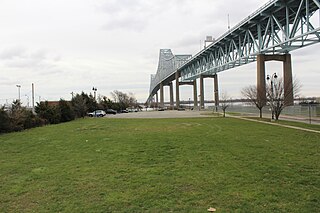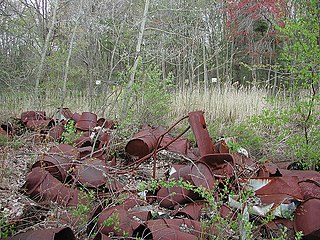Related Research Articles

Love Canal is a neighborhood in Niagara Falls, New York, United States, infamous as the location of a 0.28 km2 (0.11 sq mi) landfill that became the site of an enormous environmental disaster in the 1970s. Decades of dumping toxic chemicals harmed the health of hundreds of residents; the area was cleaned up over the course of 21 years in a Superfund operation.

The Toms River is a 41.7-mile-long (67.1 km) freshwater river and estuary in Ocean County, New Jersey in the United States.

The Kin-Buc Landfill is a 220-acre (0.89 km2) Superfund site located in Edison, New Jersey where 70 million US gallons (260,000 m3) of liquid toxic waste and 1 million tons of solid waste were dumped. It was active from the late 1940s to 1976. It was ordered closed in 1977. Cleanup operations have been underway to address environmental issues with contamination from 1980s through to 2000s. This site was one of the largest superfund sites in New Jersey having taken in around 90 million US gallons (340,000 m3). The site is heavily contaminated with PCBs, which leaked into Edmonds Creek, a tributary of the Raritan River.
Diamond Alkali Company was an American chemical company incorporated in 1910 in West Virginia by a group of glass industry businessmen from Pittsburgh. The company soon established a large chemical plant at Fairport Harbor, Ohio, which would operate for over sixty years. In 1947, the headquarters of the company was moved from Pittsburgh to Cleveland. Later the company established a plant in Redwood City, California, that produced ion-exchange resins. In 1967, Diamond Alkali and Shamrock Oil and Gas merged to form the Diamond Shamrock Corporation. Diamond Shamrock would go on to merge with Ultramar Corporation, and the combined company, Ultramar Diamond Shamrock Corporation, would in turn be acquired by Valero Energy Corporation in 2001.

Dorney Road Landfill is a 27-acre (11 ha) municipal and industrial landfill in Upper Macungie Township and Longswamp Township, Pennsylvania that was polluted with toxic waste from 1952 to 1978. The site is surrounded by rural residences and farmland. The U.S. Environmental Protection Agency (EPA) added the site to the Superfund National Priorities List in 1984. The site was remediated and removed from the National Priorities List in 2018.

The Valley of the Drums is a 23-acre toxic waste site near Brooks in northern Bullitt County, Kentucky, near Louisville, named after the waste-containing drums strewn across the area. After it had been collecting waste since the 1960s, the United States Environmental Protection Agency (EPA) analyzed the property and creek in 1979, finding high levels of heavy metals, polychlorinated biphenyls, and some 140 other chemical substances. It is known as one of the primary motivations for the passage of the Comprehensive Environmental Response, Compensation, and Liability Act, or Superfund Act of 1980. While the widely publicized Love Canal disaster is often credited as the reason the Superfund law was passed, Love Canal activist Lois Gibbs has said that Love Canal looked like a suburban community, while "Valley of the Drums became the visualization of the problem." Officially, cleanup began at the site in 1983 and ended in 1990, though later problems have been reported and investigated.

Wade Dump was a rubber recycling facility and illegal industrial waste storage and disposal facility in Chester, Pennsylvania. It was located at 1 Flower Street on the western bank of the Delaware River just north of the Commodore Barry Bridge.

The 102nd Street chemical landfill, is a former chemical landfill located on the Niagara River in Niagara Falls, New York. It is almost immediately adjacent to the infamous Love Canal chemical landfill, which are split from each other by the LaSalle Expressway and Frontier Avenue. Hooker Chemical Company, a subsidiary of Occidental Petroleum, and Olin Chemical, who were the original owners of the site, were ordered to clean up the site and pay $16,500,000 by the United States Environmental Protection Agency. It is a designated Superfund site, and is closed to the public.

Shpack Landfill is a hazardous waste site in Norton, Massachusetts. After assessment by the United States Environmental Protection Agency (EPA) it was added to the National Priorities List in October 1986 for long-term remedial action. The site cleanup is directed by the federal Superfund program. The Superfund site covers 9.4 acres, mostly within Norton, with 3.4 acres in the adjoining city of Attleboro. The Norton site was operated as a landfill dump accepting domestic and industrial wastes, including low-level radioactive waste, between 1946 and 1965. The source of most of the radioactive waste, consisting of uranium and radium, was Metals and Controls Inc. which made enriched uranium fuel elements for the U.S. Navy under contract with the U.S. Atomic Energy Commission. Metals and Controls merged with Texas Instruments in 1959. The Shpack landfill operation was shut down by a court order in 1965.
The Casmalia Resources Hazardous Waste Landfill was a 252–acre disposal facility located in the hills near Casmalia, California. During its operation, 4.5 billion pounds of hazardous waste from up to 10,000 individuals, businesses and government agencies were dumped on site. The facility was closed in 1989, and is now a listed as a Superfund Site by the Environmental Protection Agency.
Kauffman & Minteer Inc. (K&M) was an industrial transportation company that operated from 1960 to 1981 in Burlington County, New Jersey. After cleaning their trucks, they dumped the waste water into a nearby lagoon that was not properly lined. The lagoon flooded and the waste water containing chemicals, migrated over to wetlands, causing damage to vegetation and seeping into underground drinking water. The Environmental Protection Agency (EPA) got involved in 1989 and conducted a few remediation attempts but the extent of the damage is hard to determine as the different underground pathways of water are unpredictable. The site is currently an active superfund site that is closely monitored by the EPA.
Price Landfill is a 26-acre site located in Pleasantville, Egg Harbor Township, Atlantic County, New Jersey. Price Landfill is also known as Price Sanitary Landfill, Prices Pit, Price Landfill No.1 and Price Chemical Dump. The United States Environmental Protection Agency (USEPA) added Price Landfill to the Superfund National Priorities List on September 20, 1983, because of the hazardous chemicals found on the site and in the groundwater. The site was originally owned by Mr. Charles Price and was used to mine sand and gravel, which was shut down in 1968. The site was then turned into a private landfill in 1969 and then a commercial solid waste landfill in 1971. At this point the landfill was used to dispose of liquid waste by companies, specifically Atlantic City Electric Company. The liquid waste consisted of industrial chemicals, oils and greases/sludges, septic tank and sewer wastes, which were disposed on the site for 8 years, ending altogether in 1976, but in the meantime, having contaminated the groundwater, soil, air, and nearby creeks, specifically Absecon Creek. Chemicals dumped on the site are believed to be 1,2-Dichloroethane, arsenic, benzene, chloroform, lead, and vinyl chloride, all of which contaminated the groundwater, soil, air, and nearby creeks. The USEPA originally got involved in 1982 by beginning to correct the damage. Currently the USEPA states that they are continuing to monitor and treat the groundwater and land, and that hazards to humans are controlled.
Forest Waste Products is a 120-acre (49-hectare) Superfund site in Forest Township northwest of Otisville, Michigan.
A balefill is a type of landfill where solid waste is compacted and baled, typically held together with steel strapping or wrapped in plastic.

Ordot Dump, also known as Ordot Landfill, was a landfill on the western Pacific island of Guam that operated from the 1940s until 2011. Originally operated by the U.S. military, ownership was transferred to the Government of Guam in 1950, though it continued to receive all waste on the island, including from Naval Base Guam and Andersen Air Force Base, through the 1970s.
References
- ↑ "The Killing Ground". Movies & TV Dept. The New York Times . 2011. Archived from the original on May 21, 2011. Retrieved November 16, 2008.
- ↑ "The 52nd Academy Awards | 1980". oscars.org | Academy of Motion Picture Arts and Sciences. Retrieved June 8, 2018.
- ↑ Priestley, Tom; Singer, Steve, The Killing Ground, Brit Hume, retrieved June 8, 2018
- ↑ Paigen, Beverly (1982). "Controversy at Love Canal". The Hastings Center Report. 12 (3): 29–37. doi:10.2307/3561826. JSTOR 3561826. PMID 7107238.
- ↑ ABC News Close-Up: The Killing Ground (1979), October 12, 2016, retrieved June 8, 2018
- ↑ "Chemical Control fire burned 15 hours, seared memories for 35 years". njtoday.net. April 20, 2016. Retrieved June 9, 2018.
- ↑ Saxton, H. James (December 24, 1978). "Bordentown: Is It the Potential Site of a Time Bomb?". The New York Times. ISSN 0362-4331 . Retrieved June 10, 2018.
- ↑ "New Jersey vs SCA Services" (PDF). nj.gov.
- ↑ Marcus, Frances Frank (April 22, 1979). "Rural Abuse". The New York Times. ISSN 0362-4331 . Retrieved June 10, 2018.
- ↑ "Document Display" . Retrieved June 10, 2018.
- ↑ "Whistle-blower's belief in justice outweighed backlash - Special Reports | The Detroit News". blogs.detroitnews.com. Retrieved June 10, 2018.
- ↑ "Environmental Activists Coming To Nazareth". tribunedigital-mcall. Retrieved June 10, 2018.
- ↑ Greenwire, JOHN MCARDLE of (2011). "No Retreat for Veteran EPA Whistleblower in Era of 'Harsher and Vicious' Retaliation". The New York Times. ISSN 0362-4331 . Retrieved June 10, 2018.
- ↑ "History of the Shakopee Fire Department | City of Shakopee". www.shakopeemn.gov. Retrieved June 8, 2018.
- ↑ "Shakopee Dump Site Profile". cumulis.epa.gov. Retrieved June 8, 2018.
- ↑ "Silresim Chemical Corp. Site Profile". cumulis.epa.gov. Retrieved June 8, 2018.
- ↑ "A.L. Taylor (Valley of Drums) Site Profile". cumulis.epa.gov. Retrieved June 8, 2018.
- ↑ "The Love Canal Tragedy". archive.epa.gov. Retrieved June 8, 2018.
- ↑ Cruz, Gilbert (May 3, 2010). "Top 10 Environmental Disasters". Time. ISSN 0040-781X . Retrieved June 8, 2018.
- ↑ "Love Canal Site Profile". cumulis.epa.gov. Retrieved June 8, 2018.
- ↑ "Universal Oil Products (Chemical Division) Site Profile". cumulis.epa.gov. Retrieved June 10, 2018.
- ↑ "Superfund site: 'Oil Lake' in Meadowlands to get $24 million EPA cleanup". North Jersey. Retrieved June 10, 2018.
- ↑ "Kin-Buc Landfill Site Profile". cumulis.epa.gov. Retrieved June 9, 2018.
- ↑ "Bayou Sorrel Site Profile". cumulis.epa.gov. Retrieved June 10, 2018.
- ↑ "Roebling Steel Co. Site Profile". cumulis.epa.gov. Retrieved June 10, 2018.
- ↑ "Florence Land Reconstruction, Inc., Landfill Site Profile". cumulis.epa.gov. Retrieved June 10, 2018.
- ↑ "Landfill & Development Co. Site Profile". cumulis.epa.gov. Retrieved June 10, 2018.
- ↑ "White Lake rising: Hooker Chemical site shows ongoing recovery from dark past in Muskegon County". MLive.com. Retrieved June 10, 2018.
- ↑ "White Lake AOC". US EPA. December 5, 2014. Retrieved June 10, 2018.
- ↑ "Hooker Settles on Hyde Park Dump Cleanup". Chemical & Engineering News. 59 (4): 10. January 26, 1981. doi:10.1021/cen-v059n004.p010. ISSN 0009-2347.
- ↑ "Hooker (Hyde Park) Site Profile". cumulis.epa.gov. Retrieved June 10, 2018.
- ↑ "Bridgeport Rental & Oil Service Site Profile". cumulis.epa.gov. Retrieved June 10, 2018.